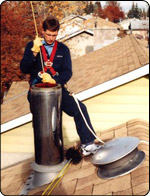10.11.2011
Chimney Cleaning
The use of wood in chimneys for heat and to create ambiance is very popular but it brings with it the need for constant, careful attention to assure safe and efficient use.
Creosote accumulation is the main reason for cleaning a chimney. If the buildup of creosote on the chimney’s inside surface ignites, a chimney fire results. Chimney’s need cleaning to prevent this buildup and thus reduce the possibility of a chimney fire.
The extremely high temperatures (up to 2,000 degrees F) of a chimney fire can damage the chimney. The heat can warp metal chimneys and crack the tile liner on masonry chimneys.

Never use water on an extremely hot chimney fire, since this quick cooling can also crack the tiler liner or warp the metal chimney. If you have a chimney fire call the fire department and in the meantime, use a multipurpose dry-chemical extinguisher (so keep one in good working order near your fireplace). As some of the chemical travels up the chimney, it may extinguish the chimney fire. After a chimney fire has been extinguished, have the chimney checked for warped metal or a cracked tile liner. It is important to repair any cracks or holes in the flue to prevent the possibility of sparks going through the cracks or holes into any other part of the homes structure. This could otherwise cause a serious house fire.
Therefore best practice is to establish a chimney cleaning schedule that will free your chimney of creosote buildup. How much you clean your chimney depends on how often it is used and the type of
wood that gets burned. Well-seasoned wood cuts down on creosote buildup.
The best method for cleaning chimneys is scraping with wire chimney brushes that come in a variety of sizes depending on the shape and size of the flue. The chimney debris is then vacuumed or swept away.
U of Missouri-Columbia

Leave a Comment